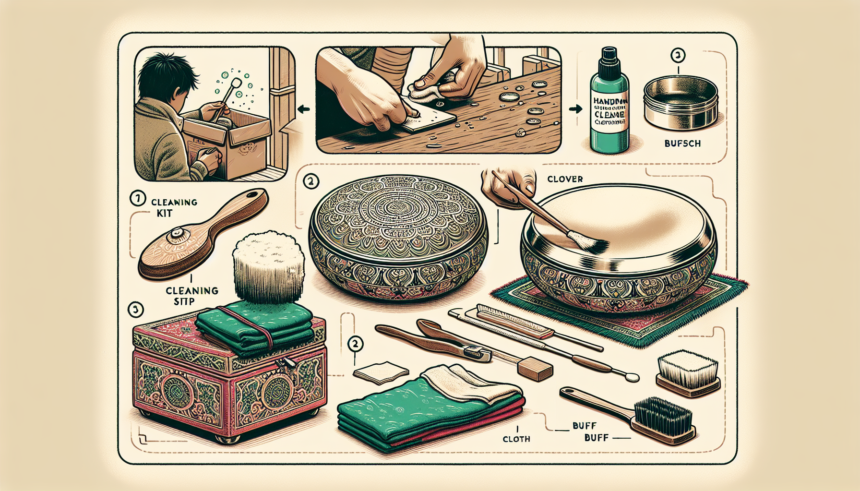Introduction
The handpan is a unique and melodic instrument known for its ethereal sounds and calming effects. Proper maintenance is essential to ensure its longevity and sound quality. Using a handpan cleaning kit is a crucial part of that maintenance. This guide will provide a detailed, step-by-step process to effectively use a handpan cleaning kit, offering tips for each step along the way.
Step 1: Gather Your Materials
Before you begin, make sure you have all the necessary materials from your handpan cleaning kit. Typically, this kit should include:
- A microfiber cloth
- Handpan cleaning solution or oil
- Dry cloth for buffing
- Protective gloves (optional but recommended)
Having everything ready and within reach will ensure a smoother and more efficient cleaning process.
Step 2: Prepare Your Workspace
Set up a clean and well-lit workspace. Place your handpan on a soft, stable surface to prevent any scratches or damage. If you’re using cleaning solutions that may spill, consider laying down some newspapers or an old towel to protect your work area.
Step 3: Initial Dusting
Begin by gently dusting your handpan with the microfiber cloth. This step removes any loose dust and debris that may have settled on the surface. Be sure to cover the entire instrument, including the top, bottom, and sides. This step is crucial as it prevents scratching when you apply the cleaning solution or oil.
Step 4: Apply the Cleaning Solution or Oil
After dusting, it’s time to apply the cleaning solution or oil. If your cleaning kit includes a spray bottle, lightly spritz the solution across the surface of the handpan. If it’s an oil, apply a small amount directly to the microfiber cloth. Using circular motions, gently rub the solution or oil into the surface. Focus on one small section at a time to ensure even coverage.
Keep in mind that less is more when it comes to cleaning solutions and oils. Applying too much can lead to a build-up, which might affect the sound quality of your handpan.
Step 5: Let It Sit
Once you’ve applied the cleaning solution or oil, let it sit for a few minutes. This allows the product to penetrate and break down any grime or tarnish that has accumulated on the surface. Refer to the instructions on your specific cleaning product for the recommended waiting time.
Step 6: Buff the Surface
Using a clean, dry cloth, begin buffing the surface of the handpan. Start with light pressure and gradually increase as needed. The goal is to remove any excess cleaning solution or oil and to polish the surface to a shine. Buff the entire handpan, paying extra attention to areas that might hold more grime, such as near the tone fields or the central dome.
Repeat this step until the handpan appears clean and has a uniform shine. Buffing not only enhances the appearance but also helps to protect the metal from oxidation and tarnish.
Step 7: Inspect Your Handpan
After buffing, take a moment to inspect your handpan. Look for any areas you may have missed or spots that might need a bit more attention. Ensure that there is no residue from the cleaning solution or oil left on the surface, as it could impact the instrument’s sound quality.
If you find any stubborn spots or areas that still seem dull, you can repeat steps 4 through 6, focusing on those specific areas.
Step 8: Safeguard Your Handpan
Once your handpan is clean and polished, consider applying a protective layer using the oil from your cleaning kit. This step is especially important if you live in a humid environment or plan to store the handpan for an extended period. The oil helps to create a barrier against moisture and air, which can prevent rust and tarnish.
Apply a small amount of oil to your microfiber cloth and gently massage it into the surface of the handpan, ensuring even coverage. Let it absorb for a few minutes, then buff any excess off with a dry cloth.
Conclusion
Maintaining your handpan with a regular cleaning routine not only keeps it looking pristine but also preserves its sound quality and longevity. Using a handpan cleaning kit offers a structured and efficient way to care for your instrument. By following the steps outlined in this guide, you can ensure that your handpan remains a source of beautiful music for years to come.
Remember, regular cleaning and proper storage are key elements in handpan care. Cleaning your handpan once every few months, or more frequently if you play often, can make a significant difference in maintaining its quality. Additionally, keeping it in a suitable case when not in use will protect it from dust, moisture, and potential damage.
Frequently Asked Questions
1. How often should I clean my handpan?
The frequency of cleaning depends on how often you play your handpan. Generally, a thorough cleaning every few months is recommended. However, if you play frequently, you may need to clean it more often to maintain its appearance and sound quality.
2. Can I use household cleaning products on my handpan?
It is not advisable to use household cleaning products on your handpan as they may contain chemicals that could damage the surface or affect the sound. Always use products specifically designed for handpan care, as they are formulated to be safe and effective for the instrument.
3. What should I do if I notice rust spots?
If you spot rust on your handpan, it’s important to act quickly. Use a rust removal product specifically designed for handpans or consult a professional for advice. Regular cleaning and application of protective oil can help prevent rust from forming in the first place.
4. Can I use the same cleaning routine for different types of handpans?
While the basic steps for cleaning are similar, it’s essential to consider the material of your handpan. Stainless steel handpans, for example, might require different care compared to those made from nitrided steel. Always refer to the manufacturer’s guidelines for specific care instructions.
5. Should I wear gloves while cleaning my handpan?
Wearing gloves is optional but recommended. Gloves can protect your handpan from fingerprints and oils from your skin, ensuring a cleaner finish. Additionally, they can provide a better grip, preventing accidental drops or slips during the cleaning process.





